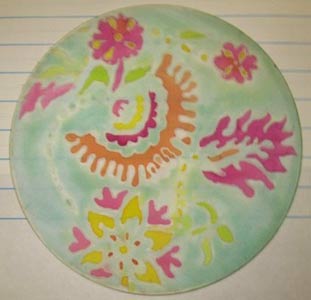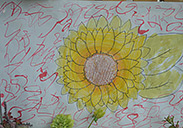Silk Painting
HOOK: Create a unique circular painting using fabric dyes on pre-stretched silk.
School: Grant Street
Elementary Teaching Artist: Wanda Leclerc
Grade Level: 1, 2, 3
Best taught in two or three class sessions


Lesson:
Students learn to paint using a traditional silk painting method. Students apply a Batik-like resist (gutta), to outline a design composed of organic and/or geometric shapes, and then fill in the shapes with fabric dye colors they have mixed.
Student:
Target Learning: Understands a combined process of ancient and contemporary techniques for dying and staining cloth.
Criteria: Identifies, describes and compares methods for creating designs on fabric seen in historical examples of Batik and modern textiles.
Target Learning: Uses line to create an organic and/or geometric Batik-like resist design on silk.
Criteria: Creates design plan using free-form curvy and/or mathematical shapes and traces onto silk using resist (gutta) applicator tip.
Target Learning: Mixes and applies warm and cool color fabric dyes to designs.
Criteria: Combines primary colors to create secondary colors on palette: uses red/yellow/orange for warm and blue/green/violet for cool color to paint all areas inside gutta lines with a soft brush.
Vocabulary (click here for the glossary)
Batik
Cool color
Dye
Geometric shapes
Gutta
Organic shapes
Palette
Primary colors
Resist process
Secondary colors
Silk
Warm color
Resources
Silk paintings by Wanda Leclerc
Books on hand-painted textiles
Sax Art Supply Catalog: Jacquard Silk Color Class Pack with step by step instructions.
Materials
Silk pre-stretched on hoops: one per student
Non-toxic silk dyes (approved for use by children)
Water-based resist (gutta)
Resist Applicator bottles and tips
Paper towels
Palettes for mixing color
Soft brushes (Purchased as a class pack by Jacquard sold through Sax Art Supplies)
Creative process and resources introduced (lesson steps) The silk painting process description below comes directly from instructions provided with the Jacquard Silk Colors Class Pack.
Teaching artist introduces Batik as an ancient traditional fabric painting technique. Students observe examples of Batik and also learn about modern methods and materials for creating designs on fabric.
Students learn that the traditional Batik silk painting style is a technique where a liquid resist is applied to outline shapes on fabric for a design, and then shapes are filled in with color. Students identify geometric and organic shapes in textile examples as well as use of warm and cool color.
First students develop a bold design on paper the same size as the silk pre-stretched hoop. Students connect lines to create organic shapes from nature or geometric shapes from math in their designs. The translucent silk (pre-stretched on hoop) is then laid over the top of the design—the design will be visible through the fabric.
Resist (gutta) is water based: it is poured into the dispenser bottle, the plastic insert is replaced, and metal tip screwed on. When drawn on the silk, the gutta resist acts as a boundary between colors: Silk dyes are then applied and naturally spread until they contact the resist lines.
The resist bottle is held like a pencil. Teaching artist demonstrates gently squeezing the bottle until the resist begins to flow. Students practice on a paper towel or scratch paper and are urged to move steadily, but not so quickly that gaps in the resist lines are created. All lines must connect or color will bleed through gaps in the resist lines.
Teaching artist puts small amounts of primary color dyes in a palette and demonstrates mixing the dyes. Students mix secondary colors and also experiment with creating pastel color through adding water. Concepts of warm and color are reviewed.
Teaching artist demonstrates dipping a soft brush into mixed colors and applying color to silk. Gently touching brush to areas at least ½ inch from resist lines and allowing color naturally to flow to resist lines is emphasized. All areas are painted inside of gutta lines with warm and cool color. Multiple colors can be used on one shape or area inside of resist lines for blended watercolor effects. Students work wet next to wet, and should never paint over a dry area with wet dye.
Teaching artist comments:
I feel this is one of the best classroom activities. From my experience, I have found that kids and adults alike, no matter what their skill level or inclinations, will have great results. The process painting the dyes on silk and watching the colors flow on the fabric is enchanting. The results will also be fun!
Assessment (strategies, forms, guidelines, reflection questions)
Peer review/critique Group critique using new vocabulary words Teacher observation and anecdote: participation in class during lesson
Essential Learnings (Art and other EALR's referenced)
Arts 1.1.1 Concepts and Vocabulary: Line, organic/geometric shape, primary/secondary color, warm/cool color
Arts 1.2 Skills and techniques: Drawing and painting
Arts 1.3 Understands and applies art styles: Describes attributes of arts styles from cultures, and times
